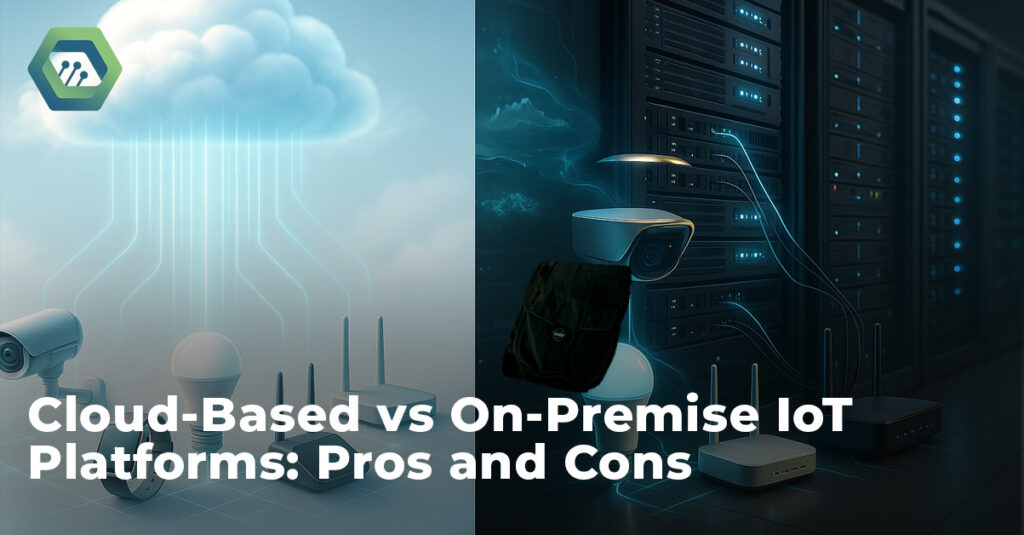The world of Internet of Things (IoT) is evolving rapidly, and one of the most critical decisions businesses must make today is choosing between cloud-based and on-premise IoT platforms. Both solutions come with their own benefits and trade-offs. Selecting the right one can significantly impact performance, cost, data control, and scalability.
In this blog, we’ll break down the key differences, advantages, and disadvantages of cloud-based vs on-premise IoT platforms — helping you make a smarter decision for your business.
What Is a Cloud-Based IoT Platform?
A cloud-based IoT platform stores and processes all data remotely on cloud servers managed by third-party providers like AWS, Microsoft Azure, or Google Cloud. Devices send data over the internet to these cloud services, where analytics, dashboards, and machine learning tools run.
Key Features:
- Remote data storage and access
- Real-time analytics
- Scalable infrastructure
- Integrations with cloud apps and APIs
What Is an On-Premise IoT Platform?
An on-premise IoT platform runs entirely within your organization’s local infrastructure. Data is stored and processed inside your own servers or private data centers. This gives complete control over data and security but often requires more IT resources.
Key Features:
- Local data hosting
- Private and secure infrastructure
- Greater customization options
- Controlled updates and configurations
Cloud-Based IoT Platform: Pros
1. Scalability
Cloud solutions are easy to scale. As your device fleet grows, cloud providers automatically allocate more storage and processing power.
2. Faster Deployment
You can deploy cloud-based IoT platforms quickly with minimal setup. No need to install hardware or configure data centers.
3. Lower Initial Costs
There’s no upfront investment in hardware or infrastructure. You pay monthly or annually based on usage.
4. Remote Access
Manage your IoT devices and access dashboards from anywhere using the internet.
5. Easy Updates
Software patches and feature updates are handled by the provider, reducing maintenance.
Cloud-Based IoT Platform: Cons
1. Data Security Concerns
Storing sensitive data in the cloud may raise compliance and security issues in highly regulated industries.
2. Internet Dependency
If your internet goes down, your platform functionality may be limited or disrupted.
3. Ongoing Subscription Costs
While upfront costs are low, ongoing subscription fees can add up over time.
On-Premise IoT Platform: Pros
1. Full Data Control
You decide where and how your data is stored, which is essential for companies with strict data policies.
2. Enhanced Security
Sensitive data stays within your private infrastructure, reducing exposure to external threats.
3. Customization
On-premise platforms can be tailored exactly to your needs, including integrations, user controls, and security protocols.
4. No Recurring Fees
Once installed, there are no monthly cloud service fees — only maintenance and upgrades as needed.
On-Premise IoT Platform: Cons
1. High Initial Costs
You need to invest in servers, software, IT teams, and infrastructure — often a large upfront expense.
2. Longer Deployment Time
Setting up hardware, networks, and systems may take weeks or months, delaying ROI.
3. Limited Scalability
Scaling on-premise systems is harder and more expensive compared to cloud solutions.
4. Manual Updates
Your team is responsible for all software updates and system maintenance.
How to Choose the Right IoT Platform?
Here are some key factors to consider before making your choice:
1. Company Size
- Startups & SMEs: Cloud-based platforms are more cost-effective and faster to deploy.
- Enterprises: On-premise may be better for sensitive data and control.
2. Compliance Requirements
Industries like healthcare, finance, and defense may prefer on-premise solutions for strict data control.
3. Budget
Cloud platforms offer pay-as-you-go models. On-premise platforms require significant upfront investment.
4. Connectivity
Remote or mobile-heavy operations benefit from cloud. Offline operations might prefer local hosting.
5. IT Resources
If you lack a dedicated IT team, cloud platforms reduce technical overhead.
Future Trends in IoT Platform Deployment
Hybrid IoT Platforms
Some businesses now adopt hybrid platforms, which combine on-premise control with cloud analytics. This gives the best of both worlds — security and scalability.
Edge Computing
Processing data closer to the source (on the “edge”) is gaining popularity, especially in time-sensitive applications like manufacturing or logistics.
AI Integration
Whether cloud or on-premise, AI and machine learning are becoming must-haves in IoT analytics, especially for predictive maintenance and automation.
Conclusion: Which Platform Is Right for You?
Both cloud-based and on-premise IoT platforms have their own strengths. The best choice depends on your business needs, resources, and long-term goals.
- Choose cloud-based IoT if you need quick deployment, low upfront cost, and remote access.
- Choose on-premise IoT if you need full control, strong data security, and full customization.
If you’re looking for a flexible and future-ready solution, OmniWOT offers a powerful IoT platform that supports both cloud and on-premise deployment. With advanced analytics, multi-protocol device support, and robust security, OmniWOT helps businesses across industries unlock the full potential of IoT.
Explore OmniWOT’s IoT Platform today and see how we can help you connect smarter!


